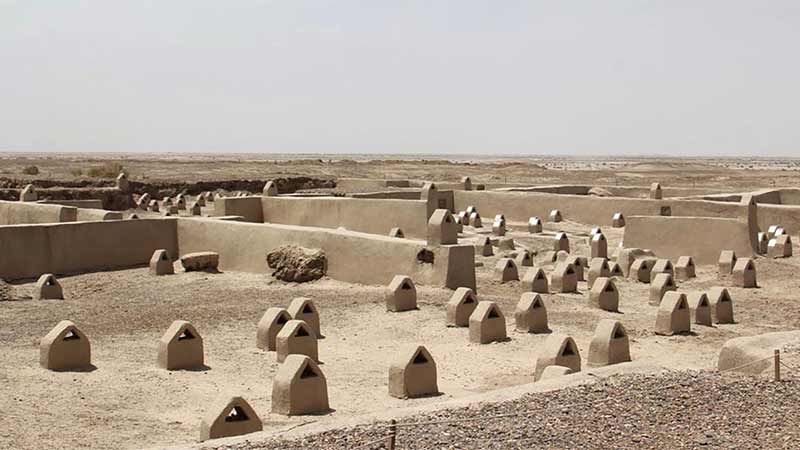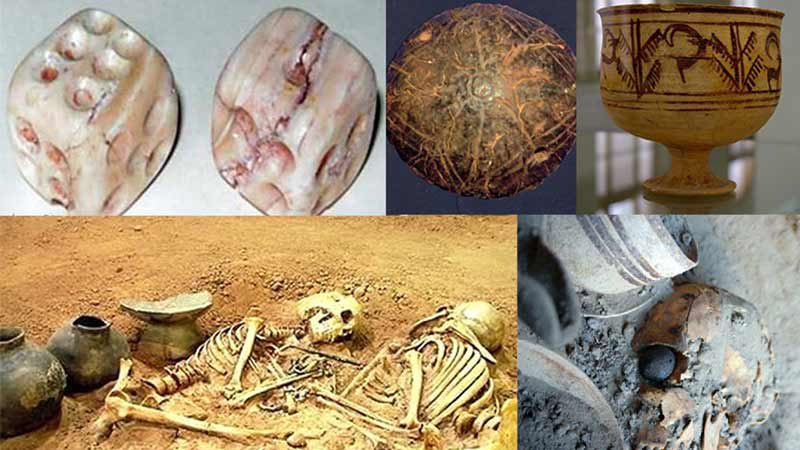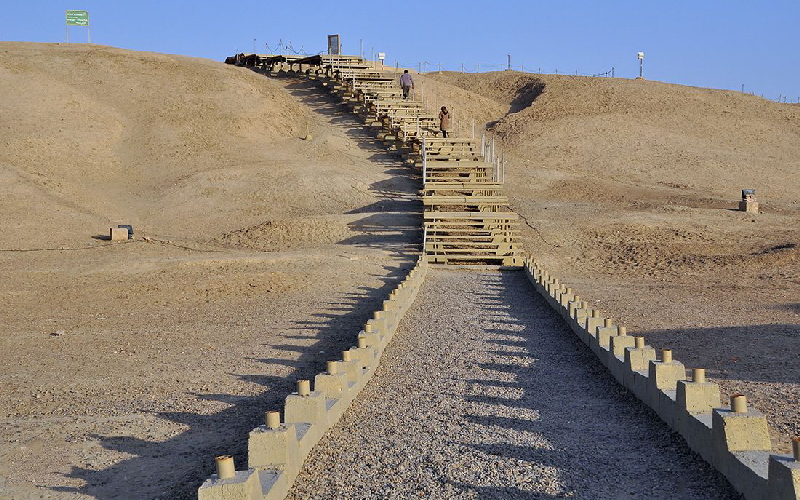Shahr-e Sukhteh, also known as the Burnt City, is recognized as one of the world’s oldest civilizations and among the earliest cities in Iran, according to archaeological findings. This historic city is a valuable area for archaeologists and history enthusiasts due to its significant historical capacity and the abundance of discovered artifacts. Visiting Shahr-e Sukhteh, you enter a museum-like desert with treasures hidden in every corner.
The vast area of Shahr-e Sukhteh is dotted with numerous historical attractions. Despite its high value, it remains less frequented compared to other tourist sites in Iran. The warm and dry climate of the Sistan and Baluchestan region, along with a lack of amenities, contribute to the limited tourist attention to this city. This article introduces Shahr-e Sukhteh, exploring its secrets and features, and provides essential information on how to access the city, the best time to visit, and accommodation options. Join us on this journey with Pari Tours Iran Travel Agency.
The Burnt City: An Ancient Marvel in Zabol
Shahr-e Sukhteh is one of the prominent attractions in Iran, located in the Sistan and Baluchestan province in the extreme eastern part of Iran. This ancient region was historically a key trade route connecting the Indian subcontinent and Central Asia with the civilizations around the Persian Gulf. Shahr-e Sukhteh encompasses a large part of Iran’s ancient civilization and the cultural roots of Eastern Iranian Plateau, serving as a hub of urban development in ancient times.
Shahr-e Sukhteh was one of the largest cities in ancient Iran and a significant civilization in Eastern Iranian Plateau, offering comprehensive insights into the culture, economy, and society of ancient Iran in the Sistan Plain. Archaeological studies and extensive historical research in this area reveal a remarkable evolution in fields such as domestic commerce, foreign trade, urbanization, architecture, medicine, art, agriculture, zoology, geology, and all sciences related to these areas.
Shahr-e Sukhteh, with a 5,000-year-old civilization, was one of the most advanced ancient cities, flourishing in sciences, diverse arts, and thriving industries.
Shahr-e Sukhteh is also known by other names such as “City of Art,” due to the discovery of significant artistic works and handicrafts, and “City of Science,” because of the remarkable scientific findings, especially in medical science. However, one of the most interesting aspects of Shahr-e Sukhteh is the absence of military fortifications and city walls, unlike neighboring cities. The lack of war weapons among the discovered items further emphasizes this point, earning Shahr-e Sukhteh the nickname “City of Peace.”

The valuable artifacts discovered in Shahr-e Sukhteh speak of the diversity of arts such as pottery, woodturning, jewelry making, and weaving in the city.
In the Sumerian civilization tablets, the names of cities where these tribes resided are mentioned. Among these, a city named “Arteh” is noted, which, based on descriptions, might be Shahr-e Sukhteh.
The name “Shahr-e Sukhteh” was given to this area about 150 years ago, following the discovery of burn marks in a rectangular building of approximately 500 meters. In this building, corridors, staircases, and thick mud-brick walls with a height of three meters were found, along with remains of burnt pillars and human skeletons. The name “Shahr-e Sukhteh” was first mentioned by the British archaeologist Sir Aurel Stein.
In 2014, Shahr-e Sukhteh was registered as Iran’s first ancient hill and the seventeenth Iranian world heritage site in the UNESCO World Heritage List.
History of Shahr-e Sukhteh
Shahr-e Sukhteh dates back more than 5,000 years and its civilization is on par with the Jiroft civilization and the Bronze Age. The different periods of urbanization in this ancient city, ranging from 3200 to 1800 BC, have been studied, and based on the findings, the life of Shahr-e Sukhteh is divided into four periods: city foundation, growth and flourishing, the beginning of decline, and the destruction phase.
The area of Shahr-e Sukhteh in the past was about 280 hectares, divided into five main sections: residential areas in the northeast and east, extensive central areas, the industrial zone in the northwest, and memorial buildings and cemeteries in the southwest. The industrial sector was located outside the city, away from residential areas.

The peak period of Shahr-e Sukhteh lasted about 300 years, between 2500 and 2200 BC, and the ancient people lived in this area for about 1,400 years. Contrary to today’s climate, the city was very green and water-rich in the past, with most inhabitants engaged in agriculture and industry. The city’s construction on the alluviums of the Helmand River made the lands fertile for agriculture, and natural elements like the Helmand River, Helmand Lake, and Khwaja Mountain added to the area’s appeal.
The use of camels for transportation and their products first occurred in Shahr-e Sukhteh. Among the most important parts discovered in Shahr-e Sukhteh, one can mention numerous courtyards, corridors, warehouses, rooms, kilns and furnaces, staircases, and other architectural spaces, along with thousands of pottery pieces and decorative objects. Other prevalent industries in Shahr-e Sukhteh include weaving, woodturning, marquetry, pottery, and metal tool manufacturing. Shahr-e Sukhteh is the only archaeological site in the country where archaeological activities have continued without interruption.
Shahr-e Sukhteh Museum
During your visit to Shahr-e Sukhteh, you can also visit the Shahr-e Sukhteh Museum. This museum displays a significant portion of the tools and items discovered from the ancient site of Shahr-e Sukhteh and other civilizations in the provinces of South Khorasan, Kerman, and Sistan and Baluchestan. Among these artifacts are pottery, stone objects, figurines, beads, and reconstructed examples of graves discovered in Shahr-e Sukhteh. The complex also includes administrative and library sections, a research department, an amphitheater, a reception hall, and sanitary facilities. The Shahr-e Sukhteh Museum is located opposite the ancient site of Shahr-e Sukhteh on the Zabol to Zahedan road.

Why Did the Shahr-e Sukhteh Burn?
One of the most intriguing questions for archaeologists studying this area is: Why did the Burnt City burn? Was it really burned? Various theories exist among archaeology experts. Initially, foreign archaeologists, observing extensive layers of ash and signs of burning in the structures, named it the Burnt City. Some experts believe the city was set on fire twice, once during its prosperous period and again at the time of its demise. However, this theory is debated, and some researchers refute it.
Modern Theories About the Shahr-e Sukhteh
Today’s archaeologists believe the ash mound covering the Burnt City was due to industrial activities nearby, not a catastrophic fire. Some experts argue that drought and depletion of water resources led to a gradual decline in livestock and agriculture. People eventually used the remains of the city for fuel and cooking, leading to its complete destruction. This theory, proposed by Mehdi Mortazavi, a professor of archaeology at the University of Sistan and Baluchestan, suggests that a fire did not cause the city’s ruin.
Industrial Activities and the Burnt City’s Ash Layer
Experts now think that the ash layer covering the Burnt City resulted from past industrial activities in the surrounding areas. Climate changes and the decline of industry and trade were among the main reasons for the city’s downfall.
Mysteries and Famous Discoveries in Shahr-e Sukhteh
During excavations, astonishing evidence revealed advancements in medical science in the past. In 1977, a mass grave was discovered, where a skull with evidence of surgery, belonging to a 13-year-old girl, was found. Historians believe this to be the earliest known brain surgery. Though the patient died months later, this skull is considered one of the most significant archaeological discoveries worldwide.
Shahr-e Sukhteh and Its Artificial Eye
Another medical breakthrough was the discovery of an artificial eye in the Burnt City’s graveyard. Made of natural tar and animal fat, it featured designs with fine gold wires resembling eye capillaries. This artificial eye, discovered in 2006 and belonging to a woman aged around 28-32, is currently preserved in a museum in southeastern Zahedan.
Reconstruction of the Woman with the Artificial Eye
In 2015, after five years of effort, archaeologists and sculptors reconstructed the skull of the woman with the artificial eye. The reconstruction, including the design of the head, eyes, skin color, hair, and nose shape, was done under the supervision of Negar Naderipour, using 3D hand design and multiple scans, a first in Iran.
Other Archaeological Finds in Shahr-e Sukhteh
The site also revealed a graveyard with mud-brick tombstones, discovered in 1992. The varying structure of these graves indicates class differences, religious beliefs, and rituals of the ancient people. Alongside the graveyard, a vast collection of pottery, utensils, and everyday items used by the people of the Burnt City was found.
The Flourishing Jewelry Industry in the Burnt City
Among the decorative items, fascinating examples of ancient jewelry made of gold and precious stones like agate, marble, lapis lazuli, and turquoise were found, indicating a thriving jewelry-making industry. The most common types of jewelry were necklaces with various gemstones.
The Burnt City’s Precision Ruler and Ancient Board Game
Excavations also unearthed a ruler made of ebony wood, measuring 10 centimeters long with precision up to one millimeter. An ancient backgammon set with 60 pieces was found, predating the oldest backgammon set previously discovered in the Royal Cemetery of Ur in Mesopotamia. The board, made of ebony wood, featured an image of a coiled snake, with pieces made of common stones of the time, such as lapis lazuli, agate, and turquoise.
The First Attempt at Animation in Shahr-e Sukhteh
In one of the 5,000-year-old graves, a cup depicting a goat next to a tree was discovered. Further analysis revealed that the image of the goat was repeated five times with slight variations, showing the goat moving towards the tree and eating its leaves. With further enhancement by designers, archaeologists produced a 20-second animation, showing the goat’s leap towards the tree. This cup, approximately 10 centimeters tall with a cylindrical base, is considered the earliest attempt by ancient artists to create a form of animation.
The Modern Lifestyle in Ancient Shahr-e Sukhteh
The wonders of Shahr-e Sukhteh are not limited to these discoveries. The social life in this ancient region was remarkably modern, evidenced by historical finds. The city had a sophisticated water and sewage system using clay pipes, remnants of which still exist, signifying modern urban living of that era. The shoemaking and textile industries were also thriving, with woven fabrics from this area being unparalleled in the surrounding regions.
Other Ancient Artifacts and Best Time to Visit the Burnt City
Other discovered artifacts include pottery with the maker’s signature, needles, hammers, pottery kilns, metal smelting furnaces, clothing buttons, combs, seeds, rice, cumin, and many everyday items. The best time to visit the Burnt City and explore this ancient marvel is early to mid-autumn. Given the open landscape, visitors should wear hats and use sun protection.

Accommodations in and Around the Burnt City
Options are limited for staying near the Burnt City. In Zabol, the only active hotel is Aram Zabol Hotel, established in 2004 and located in the city center, a 14-minute drive from the Burnt City. Other accommodations include the Kianseh ecotourism lodge in Edimi, 60 kilometers away, and the Manzelab ecotourism lodge, 15 kilometers from Zahedan and 180 kilometers from the Burnt City. For a more rustic experience, traditional clay houses in rural areas offer a unique stay, with local guides providing information and selling handicrafts and historical sculptures. These houses are surrounded by historical and archaeological sites worth exploring during your visit to Sistan.
Sightseeing Around Shahr-e Sukhteh
The province of Sistan and Baluchestan is rich in historical attractions, forming some of the most prominent sites of ancient civilization. Visitors to the Burnt City can explore other nearby attractions, including the Rostam Zabol Castle, 22 kilometers southeast, the Hoz-e-Dar windmills 7 kilometers south, the Mount Khwaja and Khwaja Ghalatan mausoleum 57 kilometers northwest, and the Ghulaman mouth 57 kilometers northeast of the Burnt City.
Conclusion
In conclusion, Shahr-e Sukhteh, known as the “Burnt City,” stands as a testament to the ingenuity and culture of ancient civilizations in what is now Iran. This archaeological wonder, dating back to around 3200 BCE, offers a unique glimpse into early urban life and has contributed significantly to our understanding of the region’s history. If you found this article enlightening and wish to share your thoughts or learn more, please feel free to leave a comment. Your insights and interest are greatly valued, and we encourage an engaging discussion about this fascinating historical site.



